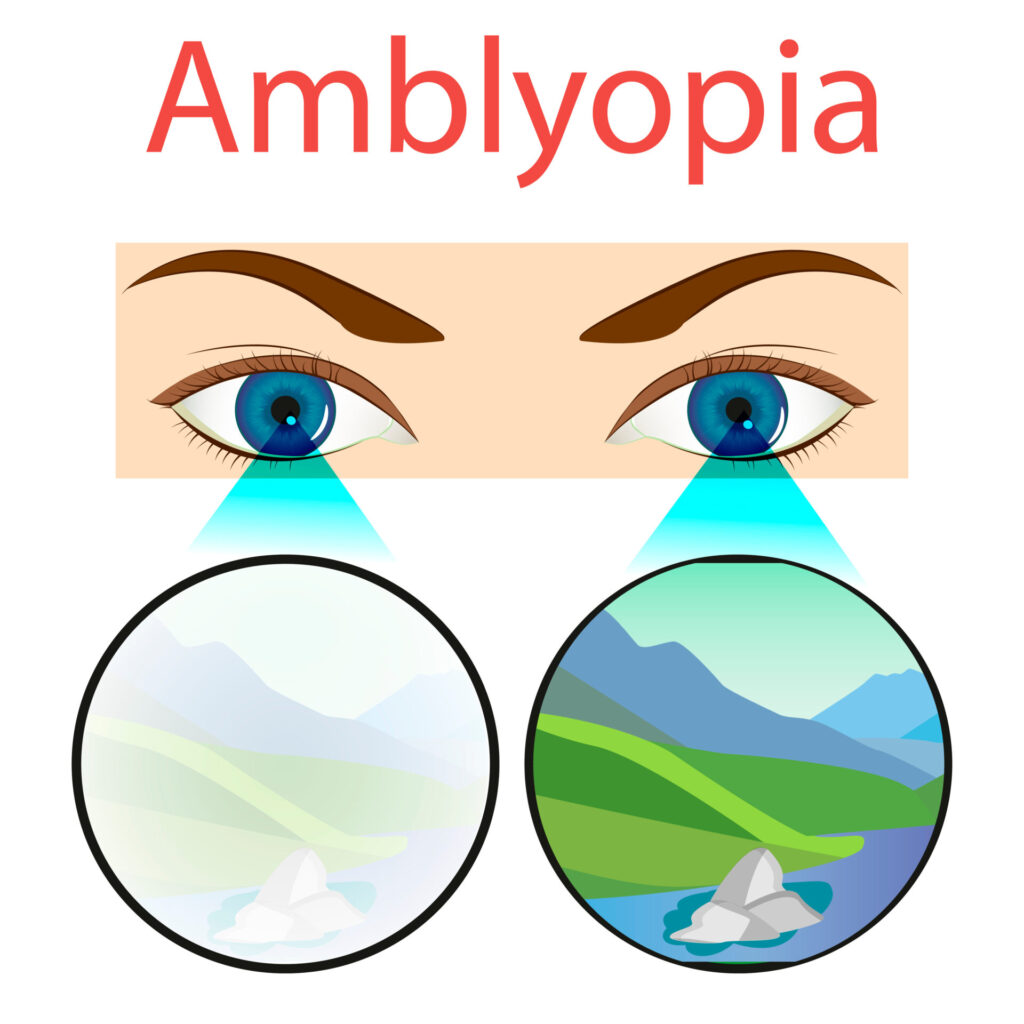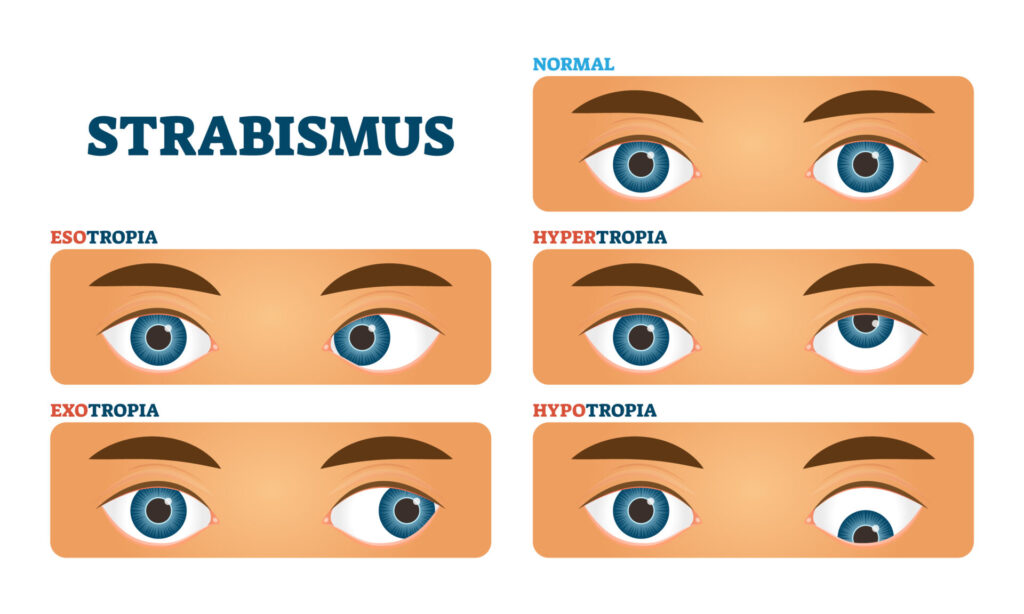Does one or both of your child’s eyes appear out of alignment, seem weaker than they should, or seem off in any way? It could be a case of either amblyopia or strabismus, two separate conditions that can cause similar complications and symptoms for your little one.
While these issues are related, it’s important to know if one is affecting your child so that you and your eye doctor can provide the proper care and treatment to help improve your child’s vision and ocular health.
What Is Amblyopia, and What Is Strabismus?
Amblyopia is the medical term for a lazy eye, where one eye exhibits vision complications and loses its connection with the brain. The brain will begin to ignore the weaker eye and rely heavily on the stronger one for vision. Amblyopia tends to occur only in one eye, and as the patient ages, the brain will depend more and more on the stronger eye, causing the weaker eye to become even more ineffective.

Strabismus is the medical term for crossed eyes, where the channels of communication between the eye and the brain are weakened, resulting in misalignment in one or both eyes. And while crossing is a type of misalignment strabismus can cause, there are actually several variations of this condition:
- Crossed eyes—the eye(s) turn inward toward the nose (esotropia)
- Walled eyes—the eye(s) turn outward (exotropia)
- Eye(s) pointing upward (hypertropia)
- Eye(s) pointing downward (hypotropia)

Strabismus patients tend to have one stronger eye that the brain relies on for vision; the other eye often becomes ignored and loses its ability to focus or see clearly (amblyopia).
Similarities and Differences Between Amblyopia and Strabismus
Determining which condition affects your child can be tricky since amblyopia often accompanies strabismus. And although these two conditions share several similarities, some differences separate them, too.
Similarities
- Both can be hereditary.
- If detected early enough, treatment is available for both conditions (usually by age 7).
- Both involve miscommunication between the brain and the eyeball.
- Untreated strabismus can lead to amblyopia in the weaker eye.
- Both conditions can cause symptoms like:
- Clumsiness
- Depth perception issues
- Hand-eye coordination issues
- Poor vision in the weaker eye (blurry or doubled)
- Eye fatigue and eye strain
Differences
- Strabismus patients show a clear misalignment in at least one eye.
- Non-strabismus amblyopia patients can appear to have normal-looking eyes, making the condition hard to detect.
- Strabismus can develop from:
- Congenital cataracts
- Damaged blood vessels
- Genetic issues
- Muscle- or nerve-affecting illness or disease
- Premature birth
- Refractive errors
- Stroke
- Amblyopia can develop from:
- Cataracts
- Ptosis
- Refractive errors
- Strabismus
How to Test for Strabismus or Amblyopia
Strabismus Tests
As mentioned, strabismus is usually noticeable since it causes at least one eye to be misaligned. Even if the misalignment is subtle, it can be easily detected by looking at your child’s eyes. However, there are screening tests your eye doctor can perform that will confirm the presence of strabismus:
Red Reflex Test—Your doctor will use an ophthalmoscope to observe the red reflex of both eyes. In normally aligned eyes, the red reflex will be identical in size, shape, and color. Any difference between the eyes can indicate strabismus.
Light Reflex Test—Your doctor will shine a light onto your child’s eyes to observe the position of the reflection. Aligned eyes will have identical reflections at the center of the eye; strabismus will cause the eyes to have differing reflections.
Cover Test—Your doctor will focus your child’s attention on an object and cover one eye to observe the uncovered eye’s behavior and movement. When the stronger eye is covered, the weaker eye will shift from misalignment to the correct position to continue focusing on the object.
Uncover Test—Your doctor will cover each eye briefly before uncovering them. During the cover period, a weak eye may shift to a misaligned position. When uncovered, the eye will shift back to a corrected position.
Amblyopia Tests
Amblyopia can be difficult to detect in your child since it does not cause directly observable eye issues like strabismus can. However, you may notice indirect problems in your child, such as difficulty catching a ball, swinging a bat, or performing other hand-eye coordination movements. Your child may also squint excessively or tilt their head often. Some screenings your doctor can perform to detect amblyopia in your child include:
Visual Acuity Test—Your doctor will conduct an age-appropriate visual acuity test to see if there are discrepancies in each eye’s visual ability.
Optical Tracking—Your doctor will move an object in front of your child and observe how each eye tracks it. If one eye shows tracking difficulty, it can indicate amblyopia.
Cover Test—Your doctor will cover each eye and observe your child’s reactions or behaviors with each covering. If the weak eye is the only one exposed, your child may become frustrated or show signs of vision difficulty.
Retinoscopy—Your doctor may use this test to observe where light is hitting your child’s retinas. If there are complications with one eye, the light will hit the retina differently than in the strong eye.
Treatment for Strabismus or Amblyopia
Strabismus Treatment
Correcting strabismus can require several different treatment options, including:
- Corrective eyewear
- Eye patches over the stronger eye (if the misaligned eye has amblyopia)
- Muscle surgery
- Eye exercises, or vision therapy
- Medications
Amblyopia Treatment
Correcting amblyopia can require treatment options like:
- Eye patches worm over the stronger eye
- Eye drops to blur the stronger eye
Are you concerned that your child suffers from strabismus or amblyopia? Schedule an appointment with Vision Eye Group for a thorough evaluation.
The ophthalmologists at Vision Eye Group can perform testing to determine your child’s eye health and vision. If we detect amblyopia or strabismus, we will begin a treatment plan as soon as possible to help strengthen your child’s eyes and promote correct alignment and stronger vision. Please schedule an appointment with our team today: 478-744-1710
Recent Articles
